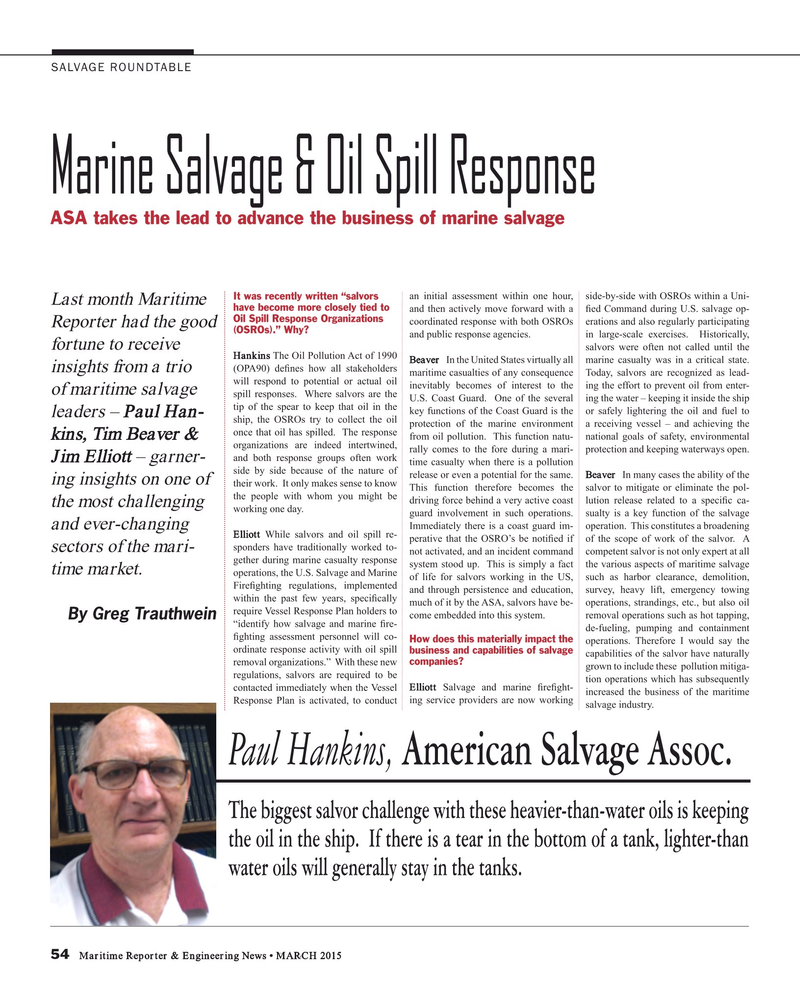
Page 54: of Maritime Reporter Magazine (March 2015)
U.S. Coast Guard Annual
Read this page in Pdf, Flash or Html5 edition of March 2015 Maritime Reporter Magazine
SALVAGE ROUNDTABLE
Marine Salvage & Oil Spill Response
ASA takes the lead to advance the business of marine salvage an initial assessment within one hour, side-by-side with OSROs within a Uni-
It was recently written “salvors
Last month Maritime have become more closely tied to and then actively move forward with a ? ed Command during U.S. salvage op-
Oil Spill Response Organizations coordinated response with both OSROs erations and also regularly participating
Reporter had the good (OSROs).” Why? and public response agencies. in large-scale exercises. Historically, fortune to receive salvors were often not called until the
Hankins The Oil Pollution Act of 1990 Beaver In the United States virtually all marine casualty was in a critical state. (OPA90) de? nes how all stakeholders maritime casualties of any consequence Today, salvors are recognized as lead- insights from a trio will respond to potential or actual oil inevitably becomes of interest to the ing the effort to prevent oil from enter- of maritime salvage spill responses. Where salvors are the U.S. Coast Guard. One of the several ing the water – keeping it inside the ship tip of the spear to keep that oil in the key functions of the Coast Guard is the or safely lightering the oil and fuel to leaders – Paul Han- ship, the OSROs try to collect the oil protection of the marine environment a receiving vessel – and achieving the once that oil has spilled. The response from oil pollution. This function natu- national goals of safety, environmental kins, Tim Beaver & organizations are indeed intertwined, rally comes to the fore during a mari- protection and keeping waterways open.
and both response groups often work time casualty when there is a pollution
Jim Elliott – garner- side by side because of the nature of release or even a potential for the same. Beaver In many cases the ability of the ing insights on one of their work. It only makes sense to know
This function therefore becomes the salvor to mitigate or eliminate the pol- the people with whom you might be driving force behind a very active coast lution release related to a speci? c ca- the most challenging working one day.
guard involvement in such operations. sualty is a key function of the salvage
Immediately there is a coast guard im- operation. This constitutes a broadening and ever-changing
Elliott While salvors and oil spill re- perative that the OSRO’s be noti? ed if of the scope of work of the salvor. A sponders have traditionally worked to- sectors of the mari- not activated, and an incident command competent salvor is not only expert at all gether during marine casualty response system stood up. This is simply a fact the various aspects of maritime salvage time market.
operations, the U.S. Salvage and Marine
Fire? ghting regulations, implemented of life for salvors working in the US, such as harbor clearance, demolition, and through persistence and education, survey, heavy lift, emergency towing within the past few years, speci? cally much of it by the ASA, salvors have be- operations, strandings, etc., but also oil require Vessel Response Plan holders to come embedded into this system. removal operations such as hot tapping,
By Greg Trauthwein “identify how salvage and marine ? re- de-fueling, pumping and containment ? ghting assessment personnel will co-
How does this materially impact the operations. Therefore I would say the ordinate response activity with oil spill business and capabilities of salvage capabilities of the salvor have naturally companies? removal organizations.” With these new grown to include these pollution mitiga- regulations, salvors are required to be tion operations which has subsequently contacted immediately when the Vessel Elliott Salvage and marine ? re? ght- increased the business of the maritime
Response Plan is activated, to conduct ing service providers are now working salvage industry.
Paul Hankins, American Salvage Assoc.
The biggest salvor challenge with these heavier-than-water oils is keeping the oil in the ship. If there is a tear in the bottom of a tank, lighter-than water oils will generally stay in the tanks. 54 Maritime Reporter & Engineering News • MARCH 2015
MR #3 (50-57).indd 54 MR #3 (50-57).indd 54 3/3/2015 2:36:05 PM3/3/2015 2:36:05 PM

 53
53

 55
55
